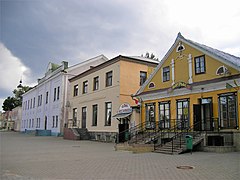| Navahrudak | |
 | |
| Arms | |
 | |
| Information | |
| Country | Belarus |
| Region | Grodno region |
| Population | 29 200 |
| Area code | 375 1597 |
| Postal Code | 231241, 231243, 231244, 231246, 231400 |
| website | |
Navahrudak - city in Grodno regionBelarus, on the Nowogródek Upland. 29.2 thousand inhabitants (2010).
Characteristic
Drive
By plane
The only airport in Belarus to which flights from Poland (Warsaw) are offered is the International Airport in Minsk.
By train
By car
Navahrudak is a local road junction. The roads from Lida, Lubcz, Baranowicz, Zdzięcioł and Minsk cross here.
By bus
You can get to Navahrudak by buses from various cities of Belarus.
Communication
Worth seeing
- The castle in Nowogródek built by Mindaugas from the mid-13th century - ruins of two towers: Szczytowa and Kościelna, earth embankments and a moat surrounding the castle. The castle was blown up by the Swedes in 1706. The foundations of the castle's Orthodox church have been preserved.
- The parish church ("Biała Fara", "Witold's Fara") under the invocation of Transfiguration of the Lord, built in the baroque style in the years 1719–1723 by rebuilding an earlier church from the end of the 14th century, funded by the Grand Duke Witold. In February 1799, Adam Mickiewicz was baptized in the church. The temple is a single-nave building with a semicircular chancel. The façade is decorated with two low quadrilateral towers and a triangular gable above them. In the outer wall of the church there is a plaque informing about the wedding of King Władysław Jagiełło with Sońka Holszańska, which took place in the parish church of Nowogródek in 1422. The main nave has barrel vaults, and in the chapels - gothic rib vaults. In the side chapel there is the miraculous painting of Our Lady of Nowogródek immortalized by Mickiewicz in the invocation to Pan Tadeusz, which is an 18th century copy of the painting that used to be in the Jesuit church in Nowogródek. There is also another valuable painting in the church, depicting St. Michael the Archangel, the patron saint of the city, moved here from the destroyed Dominican church. The painting is covered with a silver dress, funded by the voivode of Smolensk, Adam Sakowicz. A valuable monument is also a marble slab located in the Corpus Christi chapel from 1643, funded by the castellan of Nowogródek, Jan Rudomina Dussiacki, to commemorate the death of brother Jerzy and his eight comrades who died in the Battle of Khotyn. The plate shows nine kneeling knights without heads and the founder praying for their souls. In 1857, the church was closed (close to ruin), and rebuilt in 1906, it is open continuously. Next to the church, there is a stone in honor of 11 Nazareth Sisters murdered by the Nazis on August 1, 1943. The sarcophagus with their remains is in the side chapel of the church. The Servant of God Małgorzata Banaś is buried at the local cemetery.
- Late Gothic Orthodox Cathedral of St. st. Borys and Gleb, founded by Fr. Konstanty Ostrogski, built in 1517, rebuilt in 1632. Converted into a Uniate church in the 17th century. From 1839 an Orthodox church, closed in 1961 (it had an archive), returned to the faithful in 1996. Gothic ornaments have been preserved on the walls. Inside, there is a 17th-century tombstone of the Litawors Chreptowicz family.
- Dominican Church st. Michael, three-nave, baroque, with elements of Rococo. The stellar vault is preserved in the side naves. The church and monastery founded by the voivode Krzysztof Chodkiewicz from 1624, initially wooden, bricked in 1724. There was a school in the monastery, where A. Mickiewicz and Jan Czeczot studied in the years 1807–1815. In 1853 the monastery was closed and the church was rebuilt. The church was closed in 1948 and was used as a grain warehouse and then as a furniture store. Devastated, it was not renovated until 1986–1987. In 1993 it was returned to the faithful of the local Roman Catholic parish.
- Mickiewicz Manor from the second half of the 19th century Nineteenth century, on the site of the burnt seat of the Mickiewicz family from the eighteenth century. During the reconstruction, the shape of the previous building was preserved. The porch has been built over. This is where the poet spent his youth. Currently, it houses the Adam Mickiewicz Museum. Next to it, there is a reconstructed storage room, an outbuilding, a gazebo and a well.
- the former Franciscan Church (now the Church of St. Nicholas) and a monastery next to it (now a residential house). Baroque Church of st. Antoni, founded in 1714 by Tomasz Woyśmiełowicz (sub-table of Nowogródek). In 1831 the monastery was abolished, and in 1846 the baroque church was rebuilt into the Orthodox Cathedral of St. Nicholas.
- 17th century synagogue
- Tatar mosque and cemetery
- Catholic cemetery with Sadowski's chapel from 1930
- The Mickiewicz Mound
- Cloth Hall from 1812
- Mausoleum of A. Zaborski from 1802
- tenement houses from the 18th and 19th centuries
- A clerical colony in the manor style from around 1925, designed by Wilhelm Henneberg
- Provincial Court from the 1930s at ul. Minska
Nearest neighborhood
work
Science
Shopping
Gastronomy
Parties
Accommodation
- Crocus Hotel
- Apartment Na Budenogo 21
contact
Security
Tourist information
Trip
| This is outline article. For now, it includes the article schema and not much else. You can help by supplementing the article with at least basic information, making it useful. |

